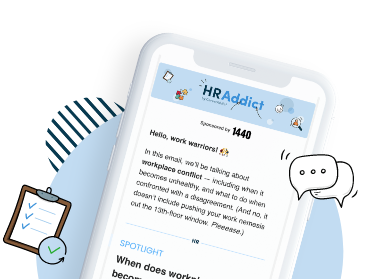Creating and implementing HR policies is fundamental to fostering a fair and positive work environment.
Without established policies and procedures, your HR department won’t be able to offer a consistent approach to issues that may arise. So, by developing HR policies that cover a range of everyday aspects that affect your business, you’ll be able to promote your company’s values and expertly manage expectations.
Policies are meant to be guidelines that lay out certain rules to help manage groups of employees. They often also include procedures that determine specific instructions.
To help you discover how to build a framework that supports your HR and business strategies, we recommend you follow the steps we’ve laid out. These tips can help you to create policies that not only comply with the relevant legislation but also improve employee satisfaction in a myriad of ways.
1. Identify the need for a new policy
Firstly, you’ll need to review and analyse the current situation. Each organisation should aim to detect specific requirements and create policies for those needs by also taking into consideration their business culture.
It could be that your company doesn’t yet have a suitable exit strategy for when employees decide to leave or are dismissed. Or perhaps there have been reported incidents around harassment and racism at work, which need to be addressed in a formal manner. These types of issues can easily arise in the workplace, and the best way of handling them is through the creation and implementation of fair HR policies.
A policy can be created where new legislation makes it obligatory or when a change happens within the company. For example, recent events have led to many companies developing remote work policies which define the rules around working from home.
Another reason to implement a new policy, or adapt an existing one, is to have consistent processes for particular tasks and areas.
Some of the most common factors that often dictate a company-wide policy include:
- Recruitment
- Holidays
- Compensation and benefits
- Disciplinary action
- Training and development
- Health and safety
2. Define clear roles when developing policies
When it comes to developing policies for your company, you will need to decide who to involve and what roles they’ll hold. Sometimes, and often in larger corporations, there are boards or committees appointed with the task of writing and reviewing policies.
For diverse policies that cater to everyone in the business, you can create a cross-functional team, including leadership, HR and other members of staff. This way, you’ll likely produce engaging policies that more people can identify with and are likely to follow. It will also give you access to more accurate information on current practices.
Each policy should have an owner. This is someone who is in charge of implementing and championing the standards and procedures identified within that specific policy.
Another key role you need to identify is that of the reviewer. This responsibility usually lies with HR, but you should adapt to your company’s needs. If there is someone more qualified to modify and adapt the policy as the business grows, then this person could be tasked with maintaining it.
3. Determine policy content
The next step is essentially a plan. In the previous step, you will have gathered the relevant information and key players involved in policy development. Together you can decide what the objective is for each policy. The content can only be produced once there is a clear blueprint of what you want to achieve by devising this policy.
A comprehensive policy should include the following elements:
- Policy name
- Objective: A general outline of the purpose of this policy.
- Specifications: The main policy details.
- Procedures: Instructions of actions to be carried out to comply with the policy.
- Eligibility: Indicating groups to whom the policy applies.
- Exceptions: In some instances, it may be necessary to indicate where exceptions can be made.
- Policy owner: The person responsible for administering the policy.
- Reviewer: The person responsible for updating the policy.
- Effective and review dates: The date at which the policy comes into effect and is modified.
- Glossary: An explanation of any specific terms.
4. Target company values
The next part to consider during your policy development process is the values and principles that your company has established. These should be reflected in the policies you choose to apply.
To ensure a successful implementation, the policies should align with the company’s goals and general philosophy. This way, employees who identify with the existing culture and code of conduct at the company will be more likely to abide by the new rules and even act as ambassadors for the brand.
Creating certain HR policies can help you to reinforce your ideals as a company. Essentially, you are also making a promise to your employees to offer equality and defend their interests.
Remember: Adapt your policies to your standards. A tech company, for example, may not want to develop a policy on social media use as they benefit from their employees’ digital activity.
You don’t need to build a policy on everything, but by using the organisation’s ethical code and developing HR policies on what’s significant to your business, you can ensure each person has a better understanding of what is expected of them at work.
5. Use simple and clear language
HR policies are not contracts. They are internal guidelines that set out specific standards for employees. They should be designed to be accessible and easy to understand. It’s beneficial for both the business and its employees to use straightforward and concise language. There is no need, therefore, to use lengthy legal speech or technical jargon. If you must add any specific terminology, make sure to define it.
The main idea of policies is to offer a time-saving course of action that allows your company to be more efficient and consistent. It will be counterproductive if your managers and employees need to ask for help just to understand the basic rules.
6. Keep it short
Although it can be tempting to create a long document explaining all the ins and outs of each aspect relating to the policy, it is advisable to be as brief as possible. Overexplaining could lead to misinterpretation.
It’s also crucial to keep the information relevant. If you write a policy on the dismissal process and start to include all possible outcomes, you’re likely going to find it overcomplicates the situation.
7. Avoid information that could quickly become outdated
As businesses grow and laws and technology develop, information can quickly change and become obsolete. Therefore, it’s vital to ensure that your policies only include pertinent and general information.
If you choose to have a policy on employment contracts, for example, ensure not to allude to specific legislation as this can frequently change, making your policy null and void. It is best to leave this information to the collective agreements and the contracts themselves. Your policies should simply outline the basic details that your staff need to know so they can act appropriately.
8. Clarify eligibility
Another important aspect to consider when writing your company’s policies is the audience. This means who the policy is for. Some policies could be particular to one team or department, while others apply to the whole organisation. This information should be clearly established in each policy.
For example, if a company has a sales team that frequently travels to visit clients, there may be a need for a specific travel or expenses policy that applies only to them.
9. Allow for necessary exceptions
When choosing which policies apply in your business, you will find that not everything has the same bearing on everyone. This means that you will sometimes need to adapt to circumstances.
It is recommended to use general language where possible as opposed to being overly specific. Words like ‘usually’, ‘typically’ or ‘may’ can help cover the possibility of exceptions.
As guidelines, your policies should leave room for interpretation and at the discretion of management to respond to certain conditions.
10. Consult key stakeholders and the legal department
Once the first draft is complete, it will be time to get some feedback. Your company policies may be a team effort, or they may be written up by an individual. Either way, before launching them, you should have both a management and a legal representative review them.
Running through the policies with management or stakeholders who’ll be affected by them will allow you to clarify any doubts and make necessary amendments.
It is also necessary to ensure that your policies don’t contradict any collective or individual agreements or specific employment contracts. This task should be undertaken by someone with legal training - either an outsourced lawyer or the internal legal team.
When you are certain that all policies comply with the relevant legislation and meet the standards established by the company, you’ll be ready for the next step.
11. Communicate policies to employees
When the time comes to implement your policies, you’ll need to inform everyone they apply to. By this stage, it’s likely you’ll already have refined the policies, so they clearly reflect the organisation’s code of conduct.
The delivery method should be impactful so that this new information isn’t overlooked. This means that sending out a mass email and assuming everyone has read it might not be the best communication technique.
What you can do, instead, is include an announcement of the email in a newsletter or arrange meetings with department heads who can raise awareness of new policies with their teams.
The policies themselves should be available to access by all staff at any time, either through an employee portal or intranet. They should also be included in your employee handbook and added to onboarding materials.
Additionally, for legal reasons, it is in your company’s best interest to have each employee acknowledge and agree to the conditions of any new policies by having them sign at the reception. Alternatively, you can set up Q&A sessions to address any concerns or clarify any final points.
12. Audit policies regularly
Once the policies are completed and have been put into effect, the maintenance begins; for your HR policies to remain valid, you’ll need to audit them on a regular basis. Usually, an annual review is sufficient. However, if any specific changes occur, the policies should be revised more often.
To keep your policies up to date, be aware of legal amendments, changes in the market, remodelling or rebranding within the business, technological advances, and business growth.
Final thoughts
The HR department is centred around people. Therefore, the policies it establishes should express this. The advantages of making your policies employee-oriented are numerous. Not only will it reinforce your employer branding, but it will help to attract and retain the best talent, and ultimately increase productivity.
Following these tips will help you create and apply effective policies that coincide with the overall HR strategy.
What are your thoughts on your company’s HR policies? How could they be developed further? Let us know in the comments section below.
This article is an updated version of an earlier article originally published back in 2017.

